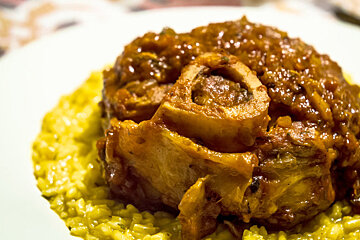
Busecchina
Traditionally prepared in autumn and winter, this dessert is made with dried chestnuts (or 'ciuchin' in the local dialect). It is typical from the Brescia, Bergamo, Mantua and Milan areas.

© NonnaBox

© Italian Food Excellence

© mangiarebuono
Discover the top Milan local cuisine
Due to its intense history and its location on the border, Lombardy has one of the most varied cuisines in Italy. Traditional Milanese recipes are usually quite heavy, probably because of its extreme weather and the influence that the French and the Austrians have had on the region. Pasta is obviously at the centre of Lombard gastronomy, but so is pork, veal, dairy, rice and corn. With their local produce, Milanese prepare deliciously decadent dishes that you can find at many of the city's restaurants.

Traditionally prepared in autumn and winter, this dessert is made with dried chestnuts (or 'ciuchin' in the local dialect). It is typical from the Brescia, Bergamo, Mantua and Milan areas.

This typical peasant's pudding has become a Christmas tradition in Milan, together with panettone. It was usually prepared on New Year's Eve.

Casoncelli are the symbol of Bergamo's cuisine. These simply stuffed pasta pockets were traditionally part of the peasants' table in the area, as they were made with leftover pork and beef.

This traditional winter Milanese casserole-type dish is made using the cheapest cuts of pork and cabbage, and has been a winter staple in the Lombardy region for centuries.

Named after the cut of meat used, the 'costola' or cutlet, this simple recipe is a classic of Milan's traditional cuisine.

This very Milanese dish is yet another example of the creativeness of the locals when using all parts of an animal. The salad's main ingredients are beef or pork cartilage, bones and tendons from the lower part of the leg.

Minestrone is a staple all around Italy, and there are as many variations as regions in the country. Basically a soup made with whatever is at hand in the kitchen, it usually contains seasonal vegetables, broth, a starchy ingredient (beans and pasta or rice), and sometimes meat .

The recipe for these meatballs was brought by the Spanish to Milan during their dominance over the region from 1535 to 1706. Thus, both their name and the way they are made derive from the Spanish 'albóndigas'.

Ossobuco is Italian for "bone with a hole" (osso = bone, buco = hole), a reference to the marrow hole at the centre of the cross-cut veal shank. The dish is a Milanese specialty of veal shanks, braised with vegetables, white wine and broth.

Called "Panaton" in Milan, this traditional Milanese sweet bread is a Christmas favourite, stuffed with dried raisins, candied citrus fruit and dusted in icing sugar.

Polenta is typical across northern Italy and it became very popular after corn was introduced in Italy in the 16th century. Typically a peasant's dish, polenta has always been regarded as a humble side to meat or vegetables, but it is a delicious one.

Very similar to the 'risotto alla zafferano', a typical Lombard dish, and also called 'risott giald', it is usually prepared as a side to substantial meat dishes such as ossobuco.